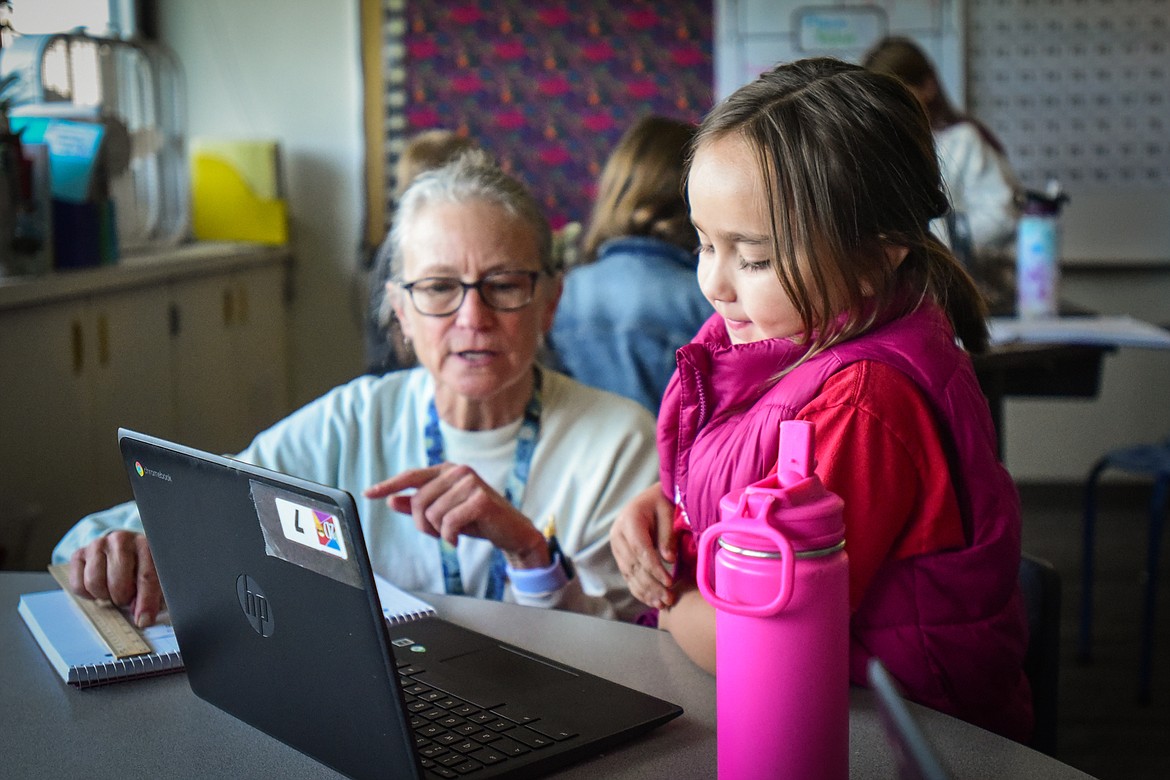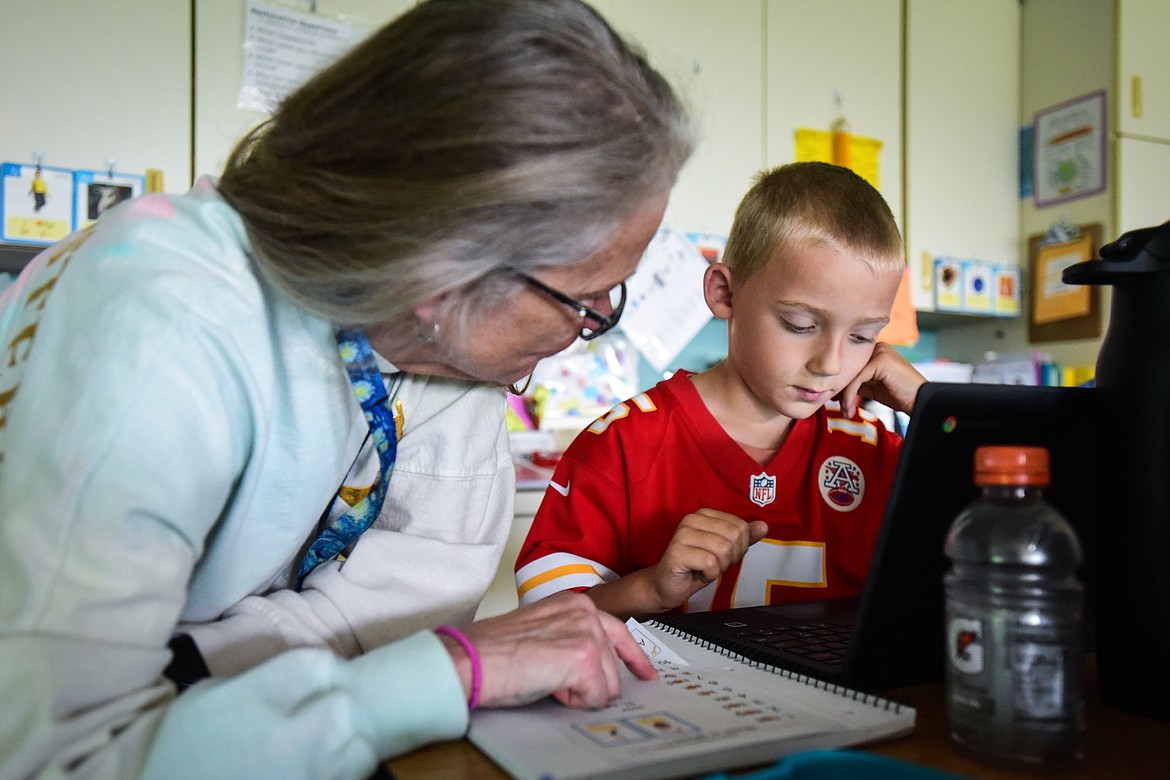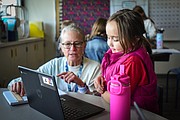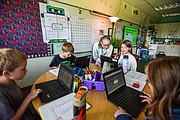Kalispell Public Schools levy requests focus on safety and technology
Safety and technology levy requests for Kalispell Public Schools are expected to fund a myriad of areas of operation, if approved, for both the elementary and high school districts.
The levy amounts of the elementary safety and technology levies are both for approximately $1.5 million. The high school district is asking for a $1.6 million safety levy and the technology levy request is for $1 million.
If the levies don’t pass the school district expects cuts to occur.
“It’s a domino effect,” interim Superintendent Randy Cline said. “In school districts a large part of the cost is personnel. Everybody knows that. That’s where a large part of the cuts have to come from if there’s cuts to be made. Maybe you can nickel and dime a lot of other things, but when it comes down to it, if you're gonna make cuts, it has to be personnel.”
The district already made personnel and curriculum cuts to balance the 2023-24 budget.
The district mailed out 44,288 ballots Monday and voters have until Oct. 3 to return them to KPS. The levies would be on the books for 10 years if passed.
Kalispell voters will see four levies on ballots — two for the high school district and two for the elementary district. Voters in 13 outlying partner districts that make up the high school district will see two levies on ballots.
The elementary and high school districts operate on separate budgets.
If the elementary safety and technology levies are approved, owners of homes with assessed market values of $300,000 can anticipate annual taxes to increase by $63.18 for each levy. This amounts to a total of $126.36 if both pass. The technology levy would replace an existing one that ends this school year.
If the high school safety levy is approved, owners of homes with assessed market values of $300,000 can expect annual taxes to increase by $27.54.
If the high school technology levy is approved, owners of homes with assessed market values of $300,000 can anticipate annual taxes to increase by $17.21.
A high school levy of any type hasn’t passed since 2007.
“You can imagine how things have changed in technology since 2007,” interim Cline said, as well as school safety.
THIS IS the first time the district has put safety levies before voters.
Revenue generated by the safety levies would go toward addressing building deficiencies or vulnerabilities identified in a safety audit conducted last year.
“Although our schools remain a safe place there are definitely things that we can do to make it safer, and so, with the safety levies we’re trying to take a comprehensive approach to addressing those issues,” Cline said.
One example would be purchasing a communication app that would create a coordinated emergency/crisis response, Cline said. He said it would give staff the ability to send out immediate notifications to district offices about where an emergency is taking place, or if, for example, a bear is roaming the playground.
The safety levies will also go toward paying positions that support student safety, mental health and well-being including school resource officers; a health, wellness and suicide prevention specialist position and counselors.
The health, wellness and suicide prevention specialist position was established in 2022 through grant funding to serve the district in response to suicide deaths in 2020-21. That grant funding ended last year and the position has been paid for with a combination of one-time and general fund money.
“Unfortunately when you look at budgets, some of those positions become the first ones on the chopping block because you don’t want to take teachers out of the classroom. At the same time, they’re really important for modern schools because there’s always internal threats at school, but you have to make sure that you can have people that could help students that might be in crisis,” he said.
The school district currently uses money from the general fund to pay for 75% of the salaries of three school resource officers at Flathead and Glacier high schools and Kalispell Middle School (who may assist elementary schools as needed). Kalispell Police Department pays for the rest.
“Those general funds are going to be stretched tighter and tighter. This safety levy would ensure SRO funding for the next 10 years,” Cline said.
The district is also interested in looking at either adding SROs for the elementary schools or creating security positions filled by people who would receive a certain level of training from the police department.
“They would not be armed but they would do things like checking doors, making sure classrooms are safe. If they notice somebody in the building that doesn’t have a visitor tag, asking them why they’re there and what they’re doing,” Cline said.
While districts do not have to cap the duration of a safety levy, KPS decided to at 10 years.
“We thought in 10 years, we would be able to make some good progress on things we want to do and then we would have more concrete results to show people,” Cline said, later adding, “And then they will agree in 10 years that we’ve done a lot of good things; we need to continue to that good work.”
TECHNOLOGY LEVIES are limited to technology-related expenses such as purchasing and maintaining equipment, like computers, networks and staff salaries/training.
“We know that technology is going to get more and more expensive and there’s going to be a greater and greater need,” Cline said.
Funding would be used to provide staff and students with updated equipment and programs needed to educate students.
“Not only is it great for students, it’s great for teachers because it allows them to enhance their teaching with real-world lessons,” Cline said.
Technology serves a variety of functions essential to personalized learning, state and classroom-level testing, grading, lesson planning and communication, for example.
On Tuesday, Edgerton Elementary second-graders in Sharon Sinclair’s class were creating “word clouds.”
“Once they’ve decided on their word cloud, they’ll download it to their Chromebook and then they’ll upload it to Seesaw [a web-based educational service],” Sinclair said. “It’s not consuming media, it's producing media — being creative.”
Sinclair, who has taught for 30 years, said technology has saved time in completing the routine tasks that go into managing a classroom, which can be spent leading small groups or one-on-one instruction while other students work on their lessons.
“I’ve got a couple of very young readers. If I can take five to 10 extra minutes a day with those kids while the other ones are doing something productive. It really helps,” she said.
It’s also allowed her to give families a more detailed look into what’s going on in the classroom.
As people may find is the case in their personal lives, access to software, apps and cloud storage, for example, are subscription/fee-based, which is the same for schools.
“The cost structure has had a massive shift from one-time purchases to everything being on a subscription model. Financially, it’s put a bigger stress on education,” KPS Information Technology Director Eric Miletich said
These fees also increase. Cline gave an example of the annual subscription increase of the district’s PowerSchool student information system costing $4 per student 10 years ago to $6 this year. Total enrollment is roughly 6,200 students. The district’s Follett Destiny Library Manager, which helps schools record and manage inventory, increased from $10,000 a decade ago to $16,000 this year.
Miletich said some vendors have minimum update requirements. He explained there’s also “forced device replacement,” which occurs when a company stops supporting a program or device.
The district has scheduled updates for equipment such as Chromebooks factoring the typical lifespan, duration of Google support and daily use.
“We try to plan a five-year rotation of equipment, that way we’re staying with that life cycle,” Miletich said.
Technology is also an area where safety overlaps.
“All day, every day, we’re constantly monitoring systems,” Miletich said, noting that hacking is mostly automated programs looking for holes to breach in an organization’s security system.
KALISPELL VOTERS already approved a $354,327 elementary general fund levy in May to fund day-to-day costs related to educating students and operating facilities — from paying teacher salaries and utilities to purchasing textbooks and supplies. That levy was expected to increase taxes on a $300,000 home by $20.
In May, voters rejected a $2.5 million general fund levy for the high school district that would have increased annual taxes by $60 on a $300,000 home.
Cline said running a second levy election this year is because there’s a need.
“What we tried to do is to articulate the need and give the voters enough information so they can make an informed decision,” Cline.
For families who don’t have students attending schools, Cline said supporting education is about preparing students for the future.
“The way I look at it is that it’s the school’s responsibility to educate the future generations. At one point, we were in school and the people that were no longer in school, or no longer had children in school, supported us.”
In addition to mailing, ballots may be dropped off at the KPS Auxiliary Administration Office, 514 E. Washington St., Kalispell. The office is open from 8:30 a.m. to 4:30 p.m. on weekdays. On Election Day, the office will be open from 8:30 a.m. to 8 p.m.
For more information visit www.sdk.k12.mt.us.
Reporter Hilary Matheson may be reached at 758-4431 or hmatheson@dailyinterlake.com.








